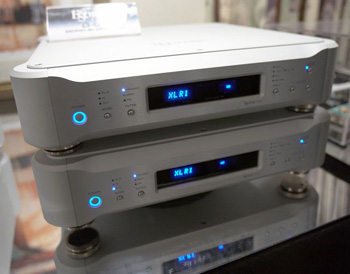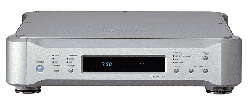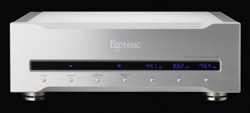The foundation for this
system is its transport, but an atomic clock adds space/time
coherence to the sound
The Esoteric components under review are a paradigm of electronic engineering
where expense wasn’t an issue, and quality has taken priority over cost.
They are expensive, but offer to the consumer a no-holds-barred playback system,
the likes of which can not be found in any other design of which I know. There
are five parts to the system and include the transport, its power supply, two
DACs (one for each channel) and a world clock. I auditioned the TEAC system with
a pair of Focal Scala loudspeakers, connected to a Boulder amplifier controlled
with the VAC preamp. These components were also used to review the Focal Scala
evaluation posted somewhere else on this site.
Appearance:
For an audiophile the four rather large components look not only impressive,
but also communicate the importance of the source component. The system had been
arranged on a resonance-inhibiting shelf, which matched the steel-grey colour
of the components and literally radiated their significance. From a technical
perspective, I would think that most high-end audiophiles would consider the
system’s appearance attractive. From an aesthetic viewpoint, this may be
questionable. However, these components are all about solidity, technology and
function, and in this light — and for me — they are simply beautiful.
The entire system was accommodated on a vibration-free stand (I do not know its
brand) that matched the components’ appearance and provided a stable foundation
for the important signal transfer.
Technology
There are simply too many technological features to discuss them all, but highlighted
here are the most important design elements of the system:
 First, the P-01 transport.
First, the P-01 transport.
The TEAC and Esoteric playback equipment has long used what the company calls
a VRDS clamping system (Vibration-free, Rigid Disc clamping System) with neo
added indicating the latest generation design. It features a magnesium turntable
with custom steel ball bearings to ascertain the smoothest running operation
possible. A 12 mm aluminum base holds the steel bridge for the construction that
accommodates an aluminum tray without a shutter. Additionally, the assembly includes
a vertically aligned optical stability platform (VOSP) and also features speed
controlled tray motion (only this model). This transport is built like the proverbial
Tiger Panzer; it measures17.5 x 6 x 16.9 inches (W x H x D) and weighs in at
62 pounds. The smaller power supply weighs an additional 35 pounds
Next up is the D-01 DAC(s)
There are two of them, one for each channel. The sonic and technical advantages
of monaural DACs include eliminating cross-talk and better power distribution
for each analog audio circuit. Additionally, separate D/A converters remove differences
in sound between the left and right channels because each separate unit has the
exact same parts and PCB layout pattern.
By avoiding a stereo converter, audible
improvements are gained. Better-defined spatial elements, such as air around
instruments and voices, superior imaging, more transparency and enhanced ambience
and presence are but a few of the audible benefits. Of course, the unit is designed
to play back Red Book and SACD formats.

The DACs’ inputs incorporate two XLR s (balanced), one RCA and two IEEE1394.SACD
DSD signals are input through the IEEE1394 or the XLR1 input terminal (original
Esoteric ES-LINK format). PCM signals can be input up to 192kHz (dual or stereo).
When the signals output by the player are either stereo or multi-channel, the
unit outputs the channel as selected by the menu.
Three digital filters allow choosing FIR, RDOT, FIR+RDOT or none at all. The
signal is converted up to 768kHz before being sent to the multi-bit D/A converter
chips, BB-PCM1704s. SACD DSD signal is converted either to 88.2kHz or176.4kHz
before inputting to the digital filter.
Signal output from the digital filter streams into D/A converter IC through a
FIFO (fast in / fast out) circuit, which reduces signal jitter. The D-01 is equipped
with eight D/A converters per unit (Burr-Brown 24bit multi-bit D/A converter:
PCM1704). With the use of eight DACs per unit, the S/N ratio and linearity is
greatly improved.
Esoteric uses +/- 42V discrete power circuit construction in the driver circuits
for analog signal outputs. This very high rail voltage produces prompt circuit
derivability and excellent transitional rates.
Each component weighs 43.4 pounds and measures 17.5 x4.25 x 16 inches (W x H
x D).
 The Master Clock G-0PRb
The Master Clock G-0PRb
The Esoteric top-of-the-line design is based on a rubidium –based atomic
clock that employs an atomic resonance frequency standard as its timekeeping
element — the most accurate standards known. Atomic clocks do not utilize
radioactivity; they use precise microwave signal emitted by electrons when they
change energy levels (additional uses for atomic clocks include GPS and the controlling
of frequencies of TV broadcasts). The G-0Rb is a delicately adjusted design,
which incorporates top quality, hand selected and carefully voiced parts. It’s
done to assure signal purity throughout the design aided by 6N copper connections
that boasts 99.99997% purity. Among other high-end parts, the unit’s power
supply employs selected capacitors that assure stability. There is a lot more
to this design, but all we need to know is that this is the most accurate clock
on the market — and the end-result is that the audio signal provided to
the other components in the system is without error — period. Its output
frequencies are 44.1kHz, 48kHz, 88.2kHz, 96kHz, 176.4kHz, 192kHz, 100kHz (universal
frequency).
Terminals are BNC and coaxial.
Power consumption is 81W. Its dimensions
complement its associated components and are 17.4" x 6" x 13.8"
(W x H x D); weight: 40 lbs.
The Sound
Before I describe what I heard while auditioning, I would like readers to know
that the high caliber of the design will reveal all flaws, including those
originating in the recoding and mixing studios. Consequently, I selected
some of my best-produced CDs from Concord, Telarc, JVC and Milestone, selected
a few more Deutsche Gramophone, Universal and Fidelio CDs for classical music
and got ready for some serious listening.
I began listening to a CD titled Todo Sobre Di Madre (Spanish Universal). The
album consists of music from the film of the same name and features the Czech
symphony orchestra and a number of solo artists. There are ten tracks, most
with orchestral passages with a large string section, but in addition to that,
there are Miles Davis-like trumpet solos as well as electronic instruments
such as Moog and electric bass. An accordion and voices round out this CD and
offers a rather complete workout for any audio system. As I am intimately familiar
with the material, I listened for sonic distinctiveness — elements I
have not heard with other top players I had auditioned over the years. It didn’t
take more than a couple of minutes into the first track, when I noticed that
the edge on forte and fortissimo passages had magically disappeared. I had
heard a little edginess with the best players I had auditioned and reviewed,
(the EMM Lab, the TEAC Esoteric P1 and the Audio Aero Prestige players) and
I had attributed the small flaw to CD production slipups. However, on the Esoteric
system the music flowed smoothly over the rough edges and introduced, instead,
an organic and phase coherent impact to the music. It seemed that the sound
was reproduced with all original phase relationships unchanged — that
is the only commonsensical explanation I have for this. I also noticed that
the material I was listening to connected me more intimately with the performers
and/or the music’s significance. As I listened more and paid particular
attention to the melodic flow of the music, I noticed a heightened sensation
of pitch and the relation of successive pitches across time. It is difficult
to explain, but I think when timing, pitch or hue, fundamentals, harmonics
and resolution all merge and become one complex element, the ear senses that
all is right, thus more fulfilling. A logical explanation is that the human
brain is incredibly responsive to timing information and can estimate the size
of an enclosed space based on reverberation and echo present in the signal
that hits the ears. We can pinpoint the position of voices and instruments
on the sound stage based on the differences of but a few milliseconds between
the times of arrival of sound at one of our ears versus the other.
Getting back to the listening sessions, I’d like to elaborate on a few
additional elements, regarding space, imaging, inner detail and harmonics.
While all quality players provide listeners with these elements, few convey
them with coherent harmony. The Esoteric system doesn’t stress one or
two of these important factors, but rather combines them all by uniting sound
staging with the series of harmonics above and below fundamental notes at fixed
intervals, in an exact fraction of length. This leaves listeners with the proper
timing impression as well a better understanding of the importance of harmonics — the
stuff that results in musicality.
The Esoteric components offer to listeners all those important elements that
reveal timbre-related accuracy such as pitch and intensity, colour and resonance.
This helps recreate musical detail, dynamics, image and resolution. Listening
to these components is not only delightful; it’s also a learning experience.
Synopsis
All commodities can be evaluated by a simple, logical rating system that takes
value and performance into consideration. Thus, it would be much uncomplicated,
if somewhat unsophisticated, to rate components as poor/bad, good, better
and best. When it comes to price vs. performance, more often than not, the
price is indicative of quality. In the audio industry, the best products
are typically expensive, although I have seen the odd exception, usually
from unknown players who have little business savvy, if any. Usually, when
components are praised as “good for the money”, it is always
for a price. However, when price isn’t a concern quality can be obtained
as manufacturers can employ the best parts available and employ the required
craftsmanship to execute prudent assembly. Also incorporated in that higher
price tag is the cost for research and development, and this can amount to
a very substantial sum.
The foundation for the entire system is the transport, on which I will comment
in the paragraph below. For now, however, l would like readers to know that I
believe this transport to be unrivaled in the industry. Thus, coupled with the
DACs and the re-clocking device to complete the playback system, the separate
components become a complex no-hold-barred playback system.
I became aware of the importance of a CD transport, way back about 15 years ago
when I auditioned the TEAC Esoteric separates, the P1 and D1. The tests my listening
panel members and I conducted showed that the transport affected the final sound
characteristics much more than a number of different DACs we had on hand at the
time. These DACs ranged in price from $200 to $7k and, though there were audible
differences, they were not blatant. However, when we changed transports, the
effects were striking. Clarity, resolution and space/time elements were markedly
better, and I remember that we were all surprised. In those days, DACs were mysterious
digitalia misunderstood by most consumers and many reviewers, including this
writer. In the early days of CD technology, jitter was often mentioned, but most
folks believed that the more or most important component was the DAC. However,
jitter or the lack of it is likely the most influencing element as it feeds the
signal into the DAC prior to conversion, and even when the transport is of superb
quality, the tiniest trace has some bearing on the sound. The Esoteric world
clock is the best of which I know that practically eliminates all jitter related
errors and may well be the component that takes the sound quality to the highest
possible degree.
